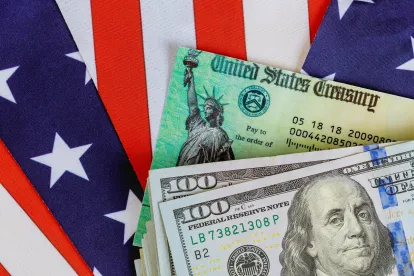Observers have spilled plenty of ink analyzing whether certain businesses, sponsored by investment firms, are supported by recent COVID-related stimulus measures. As a matter of public policy, some have debated whether portfolio companies should be supported by these measures at all. What follows is (1) a handy reference and an examination of several classes of businesses that are potentially excluded from, or may want to consider withdrawing from, recently implemented stimulus programs, (2) clarification regarding eligibility requirements of these programs and (3) our analysis of the gaps through which portfolio companies are vulnerable to falling.
The Paycheck Protection Program
Under the CARES Act, Congress implemented the Paycheck Protection Program (“PPP”) as a means to originate loans to businesses impacted by the ongoing pandemic. Applicants that are successful in their application to the PPP are eligible to receive loans up to $10 million (additional guidance regarding how to calculate your business’s maximum loan amount is available here), with a maximum interest rate of 1%, for a term of two years. PPP loans are forgivable to the extent that recipients use the proceeds to cover permitted payroll costs and overhead expenses over an eight-week period, beginning the date on which the loan is advanced to the borrowing business. Reductions by PPP loan recipients in their headcount or employee salaries during this eight-week period may result in a reduction in the amount of the PPP loan that would otherwise be forgiven.
Section 1102 of the CARES Act initially allocated $349 billion of federal funds to the PPP. On April 23, 2020, Congress passed additional legislation entitled the “Paycheck Protection Program and Health Care Enhancement Act,” which increased the total amount of available funds under the PPP by $310 billion. Under the amended PPP, the Small Business Authority (“SBA”) will guarantee up to $659 billion in loans, in aggregate, for small businesses who meet certain eligibility criteria.
The following entities are eligible for the PPP:
1. small businesses and tax-exempt nonprofit organizations that have 500 or fewer employees whose principal place of residence is in the United States
2. small businesses, even if they have more than 500 employees, if they meet the SBA employee-based or revenue-based size standards corresponding to its primary industry; 3. businesses in operation on February 15, 2020 and either had employees for whom the business paid salaries and payroll taxes or paid independent contractors (as reported on a Form 1099-MISC);
3. businesses in operation on February 15, 2020 and either had employees for whom the business paid salaries and payroll taxes or paid independent contractors (as reported on a Form 1099-MISC);
4. sole proprietors, independent contractors, and selfemployed persons in operation on February 15, 2020; and
5. businesses that meet both tests in the SBA’s “alternative size standard” as of March 27, 2020, which are (a) the maximum tangible net worth of the business does not exceed $15 million, and (b) the average net income after Federal income taxes (excluding any carry-over losses) of the business for the two full fiscal years prior to the date of the application does not exceed $5 million. The foregoing eligibility requirements are set out in the Interim Final Rules, available here and here, and has been supplemented from time to time in guidance set out in the SBA’s Frequently Asked Questions (“FAQs”). In addition, the latest Interim Final Rule, available here, provides further clarification regarding the eligibility of certain businesses.
The foregoing eligibility requirements are set out in the Interim Final Rules, available here and here, and has been supplemented from time to time in guidance set out in the SBA’s Frequently Asked Questions (“FAQs”). In addition, the latest Interim Final Rule, available here, provides further clarification regarding the eligibility of certain businesses.
Gap One: With respect to the PPP, (A) businesses with fewer than 500 employees but are required under guidance from the SBA to be aggregated with “affiliates” because they are sponsored by private equity, venture capital, and other investment funds, (B) certain businesses with access to other sources of liquidity and (C) businesses that are “Ineligible Businesses” or otherwise don’t meet eligibility requirements under the SBA’s regulations or continuing guidance
Although businesses with fewer than 500 employees are eligible to apply for the PPP, many such businesses that are sponsored by private equity, venture capital, and other investment funds are excluded as a direct result of the “affiliation” of these businesses with the funds sponsoring them.
Importantly, the SBA recently clarified in its Interm Final Rule that while hedge funds and private equity firms are ineligible for PPP loans since they are primarily engaged in investment or speculation, portfolio companies of such sponsors are not by default ineligible. However, the “affiliation” test that the SBA uses to determine eligibility nonetheless appears to exclude many sponsored businesses from receiving PPP loans. The SBA’s guidance released on April 3, 2020 clarified that affiliation will exist under any of four different circumstances: (1) affiliation based on ownership; (2) affiliation arising under stock options, convertible securities, and agreements to merge, (3) affiliation based on management, and (4) affiliation based on identity of interest. Therefore, such affiliation almost certainly excludes companies backed by private equity, and likely also excludes businesses supported by venture capital and other investment firms, most of which will have ownership or management interests across their portfolio companies.
In response to the public outcry that ensued after it was revealed that very large organizations were approved for the first round of PPP loans, the SBA also explicitly deemed as ineligible for PPP loans businesses having other sources of funding available or otherwise viewed as not having sufficient need for PPP funding. In a FAQ issued on May 6, 2020 (FAQ #31), the SBA declared that, in certifying the necessity of PPP loans, borrowers must “tak(e) into account their…ability to access other sources of liquidity sufficient to support their ongoing operations in a manner that is not significantly detrimental to the business.” This guidance applies to both public and private businesses, and applies no matter the size of the business. As a direct result of this guidance, many potential borrowers decided to return the PPP funds that they received, withdraw their PPP application, or choose not to apply
However, on May 13, 2020, the SBA updated its response to FAQ #31 by announcing in FAQ #46 that they have added a safe harbor for “any borrower that, together with its affiliates, received PPP loans with an original principal amount of less than $2 million.” Such borrowers will now be “deemed to have made the required certification concerning the necessity of the loan request in good faith.” Furthermore, borrowers that do not satisfy this new safe harbor because they have received loans with an original principal amount in excess of $2 million, may still have an adequate basis for making the required goodfaith certification, depending on the individual borrower’s circumstances. However, these larger loans will be subject to audit by the SBA.
Finally, the SBA may also classify as ineligible for PPP loans certain entities in gambling or other vice businesses, insurers, real estate developers/landlords, and lenders, among others.
Alternative: The Main Street Lending Program
The Federal Reserve’s Main Street Lending Program is available to businesses with fewer than 15,000 employees or less than $5 billion in 2019 revenue. There is no employee minimum, so the Main Street Lending Program may be a viable alternative for businesses with fewer than 500 employees that may not have been eligible for a PPP loan because of the SBA affiliation guidance discussed above, or for businesses unable to demonstrate sufficient funding need because of their access to other sources of capital. Note, however, that the Main Street Lending Program incorporates by reference the SBA’s affiliation guidance—so the Main Street Lending Program may also be unavailable if the potential borrower is part of a large investor portfolio that would aggregate pursuant to the SBA affiliation guidance to more than 15,000 employees and more than $5 billion in 2019 revenue.
The Main Street Lending Program is composed of three facilities: the Main Street New Loan Facility (“MSNLF”), the Main Street Expanded Loan Facility (“MSELF”), and the Main Street Priority Loan Facility (“MSPLF,” and collectively, the “Main Street Lending Facilities”). The Main Street Lending Program employs a Federal Reserve special purpose vehicle (“SPV”) to purchase participation interests in eligible loans from originating lenders, with the originating lender retaining the remaining amount.
• The MSNLF will purchase 95% participation interests in new loans of up to $25 million (subject to a 4x leverage ratio).
• The MSPLF will purchase 85% participation interest in new loans of up to $25 million (subject to a 6x leverage ratio).
• The MSELF will purchase 95% participation interests in new tranches of up to $200 million (subject to a cap of 35% of total indebtedness and a 6x leverage ratio) added to existing loans.
Each eligible borrower for the three facilities must:
1. not be an “ineligible business”, which references aspects of the SBA’s eligibility guidance for the PPP;
2. be a business that was established prior to March 13, 2020;
3. be a business that was organized for profit as a partnership, a limited liability company, a corporation, an association, a trust, a cooperative, joint venture with no more than 49 percent participation by foreign business entities, or a tribal business concern as defined in 15 U.S.C. §657(b) (2)(C);
4. meet at least one of the following two conditions: (a) has 15,000 employees or fewer, or (b) has up to $5 billion in 2019 annual revenues;
5. be created or organized in the United States or under the laws of the United States with significant operations in, and a majority of its employees based in, the United States; and
6. have had, or had an eligible loan that had, as applicable, a rating equivalent to “pass” in the lender’s internal Federal Financial Institutions Examination Council rating system.
Borrowers may not participate in more than one of the Main Street Lending Program Facilities and may not participate in any of these facilities if they are also utilizing the Federal Reserve’s Primary Corporate Federal Facility. Additionally, such borrowers may not have received specific support under the Coronavirus Economic Stabilization Act of 2020 (Subtitle A of Title IV of the CARES Act).
Alternative: Employee Retention Credit and Delayed Payroll Tax Payment
Tax provisions of the CARES Act allow a payroll tax credit of up to $5,000 per employee (the “Employee Retention Credit”) and the ability to defer current payroll tax payments obligations, with those deferred obligations becoming payable by 50% at year-end 2021, and 50% at year-end 2022. This Employee Retention Credit applies to qualified wages paid after March 12, 2020, and before January 1, 2021; however, PPP borrowers are not eligible for the Employee Retention Credit.
According to IRS guidance, employers who have received a PPP loan may defer deposit and payment of the employer’s share of Social Security tax that otherwise would be required to be made beginning on March 27, 2020, through the date the lender issues a decision to forgive the PPP loan. Once an employer receives confirmation from its lender that its PPP loan is forgiven, the employer is no longer eligible to defer deposit and payment of the employer’s share of Social Security tax due after that date.
The availability of these provisions may cushion part of the impact for businesses that are not eligible for PPP loans, or were not able to obtain PPP loan forgiveness.
Gap Two: Businesses with more than 15,000 employees and more than $5 billion in 2019 revenue, or smaller businesses that due to investor ownership are required to aggregate with “affiliates” and on an aggregated basis are above those thresholds.
Businesses that exceed both of these thresholds, either as an individual legal entity or due to aggregation with “affiliates”, are not eligible for Main Street Lending Program loans.
Alternative: Primary Market Corporate Credit Facility (“PMCCF”)
Businesses that are ineligible to participate in the Main Street Lending Program because they have (aggregated with their affiliates, if applicable) more than 15,000 employees and $5 billion in 2019 revenue may be eligible to obtain support from the Federal Reserve’s PMCCF, if the business is currently rated as investment grade, or if the company was recently investment grade.
The PMCCF is designed to act as a funding backstop for corporate debt issued by eligible entities. The Federal Reserve Bank of New York has committed to lend to an SPV on a recourse basis. The SPV will (1) purchase qualifying bonds as the sole investor in a bond issuance; and (2) purchase portions of syndicated loans or bonds at issuance. The initial allocation by the Department of Treasury toward this facility will be $50 billion.
The bonds purchased under this program must have a maturity of four years or less, and the SPV may purchase no more than 25 percent of any loan syndication or bond issuance. The maximum amount of outstanding bonds or loans of an eligible issuer that borrows from the facility may not exceed 130 percent of the issuer’s maximum outstanding bonds and loans on any day between March 22, 2019 and March 22, 2020.
The pricing for eligible corporate bonds will be issuer-specific and informed by market conditions, plus a one percent facility fee. The tranches purchased of eligible syndicated loans and bonds will be priced the same as the tranches held by other members of the syndicate, plus a one percent facility fee on the share of the syndication held by the PMCCF SPV.
The PMCCF will purchase eligible assets until no later than September 30, 2020 unless the Board of Governors of the Federal Reserve System and the Treasury Department extends this date. The New York Fed will continue to fund the PMCCF until the PMCCF’s holdings either mature or are sold. To be eligible, the issuer:
1. must be a business that is created or organized in the United States or under the laws of the United States with significant operations in, and a majority of its employees based in, the United States;
2. as of March 22, 2020, must have been rated at least BBB-/ Baa3 by a major nationally recognized statistical rating organization (“NRSRO”), and must have been rated at least BBB-/Baa3 by two or more NRSROs if rated by multiple nationally recognized statistical rating organizations, as of March 22, 2020;
3. must not be an insured depository institution or depository institution holding company, as such terms are defined in the Dodd-Frank Act;
4. will not have received specific support pursuant to the CARES Act or any subsequent federal legislation; and
5. must satisfy the conflict-of-interest requirements of Section 4019 of the CARES Act, which are designed to prohibit companies owned by senior government officials from benefitting from stimulus funds.
Gap Three: Severely distressed companies, including companies in bankruptcy
Although PPP loans are unavailable to companies in bankruptcy, they do not require demonstration of sound financial standing. As such, PPP loans are available to (and, in theory, targeted toward) severely distressed businesses that have not filed for bankruptcy. The Main Street Lending Program, however, explicitly requires lenders to underwrite and structure loans consistent with the underwriting policies of that bank. The loans may be secured or unsecured, subject to certain requirements, and do not require personal guarantees. However, the term sheet requirements are described as a “minimum”, and lenders may limit the size of loans or may require collateral or guarantees consistent with their credit policies.
Additionally, Main Street Lending Program borrowers must certify that they have a good faith belief that, after giving effect to receipt of the Main Street Lending Program loan, the business will be able to satisfy its financial obligations for at least 90 days and does not plan to file for bankruptcy protection. Consequently, the borrowers most severely impacted by the COVID-19 pandemic and related economic consequences may be effectively shut out of these assistance programs. What’s more, no other backup assistance alternative may be available.
Gap Four: Asset-based borrowers, non-profit organizations and other organizations for which (a) EBITDA is not a relevant metric and (b) are not eligible for the PPP
The Main Street Lending Program utilizes 2019 adjusted EBITDA as a metric along with a maximum leverage ratio to arrive at a maximum loan amount. This makes the program, as currently formulated, unworkable for borrowers for which the EBITDA metric is not an applicable concept. This includes firms that engage in asset-based borrowing via vehicles that do not have earnings from operations, and non-profit organizations. Federal Reserve guidance in connection with Main Street Lending Program indicates that the Fed is looking into alternative metrics that would allow the asset-based borrowers to participate, and is considering the feasibility of adding non-profit organizations as eligible borrowers. Certain other types of businesses, such as professional associations, where all or virtually all of the annual earnings are paid out to owners/employees on an annual basis and where the business itself does not recognize material annual earnings at the legal entity level, may also be effectively ineligible.
Gap Five: Highly leveraged businesses that are not eligible for the PPP
The Main Street Lending Program prohibits the borrower’s maximum loan amount, when added to the borrower’s existing debt (including committed, but undrawn debt), from exceeding a specified leverage ratio when compared against the borrower’s 2019 adjusted EBITDA. The leverage ratio is 4x in the case of the MSNLF, and 6x in the case of the MSPLF and MSELF. As a result, borrowers with high existing leverage, that had relatively poor 2019 earnings performance, or both, may be ineligible for Main Street Lending Program loans or may only qualify for a reduced amount.
Gap Six: Real Estate Companies
Passive developers and landlords of rental real estate that do not actively use or occupy the assets acquired or improved with the loan proceeds are, subject to certain exceptions, expressly ineligible for the PPP and by extension the Main Street Lending Program. Even entities that may not be expressly excluded from the Main Street Lending Program may be effectively unable to access the program if their existing mortgage indebtedness leaves them unable to meet the leverage ratio requirements, or otherwise unable to support the underwriting of new secured or unsecured debt.
Gap Seven: Non-U.S. Companies with U.S. Operations
Non-U.S. companies with U.S. subsidiaries may qualify for assistance under the CARES Act provided they meet the below criteria, and subject to any further guidance that may be promulgated by U.S. Treasury and the Federal Reserve. While Congress passed the CARES Act to provide relief for U.S.-based businesses, there has been no information released to date expressly excluding U.S. businesses owned or operated by foreign entities or individuals.
Pursuant to the CARES Act, a business that has not otherwise received “adequate economic relief in the form of loans or loan guarantees” may be eligible for assistance if:
1. it is created or organized in the United States or under the laws of the United States;
2. has significant operations in the United States; and
3. a majority of its employees are based in the United States.
While U.S. subsidiaries of non-U.S. companies generally meet these eligibility requirements, there remains ambiguity as to how these criteria should apply. Eligibility will therefore need to be considered on a case-by-case basis. The CARES Act does not define “significant operations” or “majority of employees.” Additional guidance is expected, but the U.S. Treasury and the Federal Reserve are yet to advise on the details of these concepts.
A U.S. affiliate of a foreign entity that meets these threshold requirements should benefit from certain stimulus loan programs, including the PPP, the Main Street Lending Program, and the PMCCF. Such entities would also have to meet the loan program-specific requirements discussed above.
Generally, a U.S. subsidiary that operates primarily in the U.S. and has a majority of its employees based in the U.S. would likely qualify for support under the CARES Act.
A U.S. subsidiary with operations overseas, or one that relies on both a U.S. and foreign workforce would require more careful analysis into the subsidiary’s operations and personnel. Based on a plain-reading of the CARES Act, foreign subsidiaries cannot access the stimulus programs, even if their U.S.-based counterparts may qualify for relief. Multijurisdictional companies have additional factors and constraints to consider, including:
1. An eligible borrower under the PPP loan program must carefully consider the “affiliation” rules that appear in 13 CFR 121.301(f). Multijurisdictional companies with complex structures will inevitably require a more complex “affiliation” analysis.
2. As discussed, recent guidance issued by U.S. Treasury requires an eligible borrower to consider its access to other sources of liquidity before certifying that there exists economic necessity for a PPP loan. The guidance additionally states that the business should be prepared to demonstrate the basis for such certification, subject to a safe harbor for businesses, together with their affiliates, that borrow less than $2 million. Applicants should therefore consider conducting a fact-specific review of a company’s ability to access liquidity from its foreign sources to satisfy the certification requirement and to prepare for a possible audit.
3. An eligible borrower under the Main Street Lending Program is restricted from making payments of dividends or other capital distributions for the life of the loan plus 12 months. Non-U.S. companies that rely on regular receipt of cash from its U.S. subsidiaries should consider how these cash-flow restrictions could impact its operations.
4. Restrictions on distributions will also likely include intercompany loans to foreign affiliates in an effort to prevent the circumvention of the primary purpose of the CARES Act: to support U.S. businesses and promote the retention of their U.S. employees.
5. The new term sheets for the Main Street Lending Program place certain restrictions on the borrower in terms of contractual subordination or priority and security as to the borrower’s other loans or debt instruments. For the MSNLF, the loan may not be contractually subordinate to any of the borrower’s other loans or debt instruments. The other two facilities under the Main Street Lending Program require such debt to be senior to, or pari passu with, the borrower’s other debt, not including mortgage debt. Multijurisdictional entities should consider how these restrictions may impact the business’s ability to incur additional outside debt as well as intercompany debt.
While a U.S. subsidiary of a non-U.S. company is not precluded from seeking stimulus bill relief, the specific terms of each loan program should be carefully considered to ensure that (1) the company is able to meet the eligibility requirements and (2) the requirements under the loan program will not upset the company’s ongoing business operations Conclusion The various stimulus programs that the US government and regulators have implemented to support businesses adversely impacted by the current global pandemic, while a lifeline to some businesses, leave many businesses to fend for themselves. This is particularly true for businesses supported by private capital. Even for portfolio companies eligible for stimulus relief, private equity funds, venture capital funds, and other investment funds will need to remain alive to the potential reputational impact that accepting government support for its portfolio companies will have if that support is made public. In many cases, the juice may not be worth the squeeze.
For the smaller subset of businesses that are both eligible for support, and for which the need for stimulus outweighs any potential reputational harm, authorized persons at these organizations should create a written, contemporaneous record detailing the need, calculations and analysis underpinning the decision to apply. Regulators have repeatedly supplemented, clarified, and arguably changed many of the rules governing these stimulus programs since the CARES Act was signed into law on March 27, 2020. In the relatively short life of these programs, successful applications have already been scrutinized, both by regulators, and by the public. For businesses and organizations that successfully receive stimulus support, including those supported by private capital, a written, contemporaneous record will go a long way to support the required certification that their application has been made in “good faith”.









 />i
/>i

